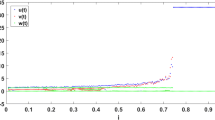Abstract
In this paper two interacting species in presence of adaptation (dormancy of the predators such as resting eggs) has been discussed. The dormant stage is an equipment to survive in harsh environment. We have discussed the stability analysis of system without diffusion and in presence of diffusion. Our numerical investigation reveals that above the critical value of interference among the zooplankton the system become stable. Spatiotemporal pattern shows a transient complex spatiotemporal pattern by increasing the time and space.
Access this chapter
Tax calculation will be finalised at checkout
Purchases are for personal use only
Similar content being viewed by others
References
Harper, J.L.: Population Biology of Plants. Academic Press, London (1977)
Wiggins, G.B., Mackay, R.J., Smith, I.M.: Evolutionary and ecological strategies of animals in annual temporary pools. Arch. Hydrobiol. Suppl. 58, 97–206 (1980)
Henis, Y.: Survival and Dormancy of Microorganisms. Wiley, Hoboken (1987)
Piltz, S.H., Porter, M.A., Maini, P.K.: Prey switching with a linear performance trade-off. SIAM J. Appl. Dyn. Syst. 13, 658–682 (2014)
De Stasio Jr., B.T.: The role of dormancy and emergence patterns in the dynamics of a freshwater zooplankton community. Limnol. Oceanogr. 35, 1079–1090 (1990)
Hutchinson, G.E.: A Treatise on Limnology. Wiley, Hoboken (1967)
Slusarczyk, M.: Food threshold for diapause in Daphnia under the threat of fish predation. Ecology 82, 1089–1096 (2001)
Slusarczyk, M.: Predator-induced diapauses in Daphnia. Ecology 76, 1008–1013 (1995)
De Stasio, B.T.: The role of dormancy and emergence patterns in the dynamics of a freshwater zooplankton community. Limnol. Oceanogr. 35, 1079–1090 (1990)
Kuwamura, M., Nakazawa, T., Ogawa, T.: A minimum model of prey-predator system with dormancy of predators and the paradox of enrichment. J. Math. Biol. 58, 459–479 (2009)
Kuwamura, M., Chiba, H.: Mixed-mode oscillations and chaos in a prey-predator system with dormancy of predators. Chaos 19, 043121 (2009)
Nakazawa, T., Kuwamura, M., Yamamura, N.: Implications of resting eggs of zooplankton for the paradox of enrichment. Popul. Ecol. 53, 341–350 (2011)
Wang, J., Jiang, W.: Bifurcation and chaos of a delayed predator-prey model with dormancy of predators. Nonlinear Dyn. 69, 1541–1558 (2012)
Kuwamura, M.: Turing instabilities in prey-predator systems with dormancy of predators. J. Math. Biol. 71, 125–149 (2015)
Upadhyay, R.K., Thakur, N.K., Rai, V.: Diffusion driven instabilities and spatio-temporal patterns in an aquatic predator-prey system with Beddington-DeAngelis type functional response. Int. J. Bifur. Chaos 21, 663–684 (2011)
Scheffer, M.: Ecology of Shallow Lakes. Chapman and Hall, London (1998)
Garvie, M.R.: Finite difference schemes for reaction-diffusion equations modeling predator-prey interactions in MATLAB. Bull. Math. Biol. 69, 931–956 (2007)
Acknowledgements
This research work is supported by Chhattisgarh Council of Science and Technology, India under grant no. 2238/CCOST/MRP/2015 to the corresponding author (Nilesh Kumar Thakur).
Author information
Authors and Affiliations
Corresponding author
Editor information
Editors and Affiliations
Rights and permissions
Copyright information
© 2020 Springer Nature Singapore Pte Ltd.
About this paper
Cite this paper
Thakur, N.K., Ojha, A., Tiwari, S.K. (2020). The Role of Adaptation in Plankton System with Beddington-DeAngelis Type Functional Response. In: Manna, S., Datta, B., Ahmad, S. (eds) Mathematical Modelling and Scientific Computing with Applications. ICMMSC 2018. Springer Proceedings in Mathematics & Statistics, vol 308. Springer, Singapore. https://doi.org/10.1007/978-981-15-1338-1_2
Download citation
DOI: https://doi.org/10.1007/978-981-15-1338-1_2
Published:
Publisher Name: Springer, Singapore
Print ISBN: 978-981-15-1337-4
Online ISBN: 978-981-15-1338-1
eBook Packages: Mathematics and StatisticsMathematics and Statistics (R0)




